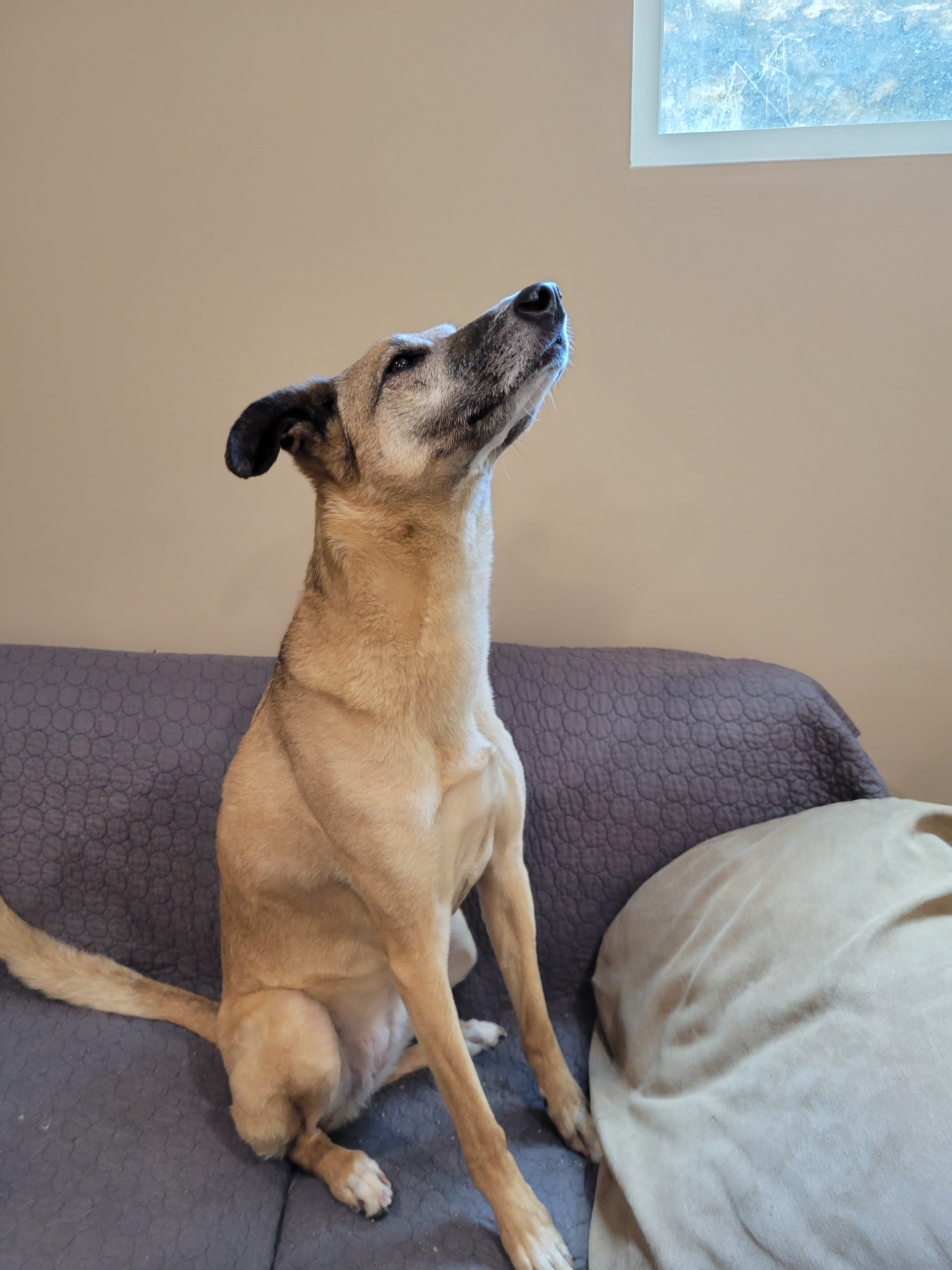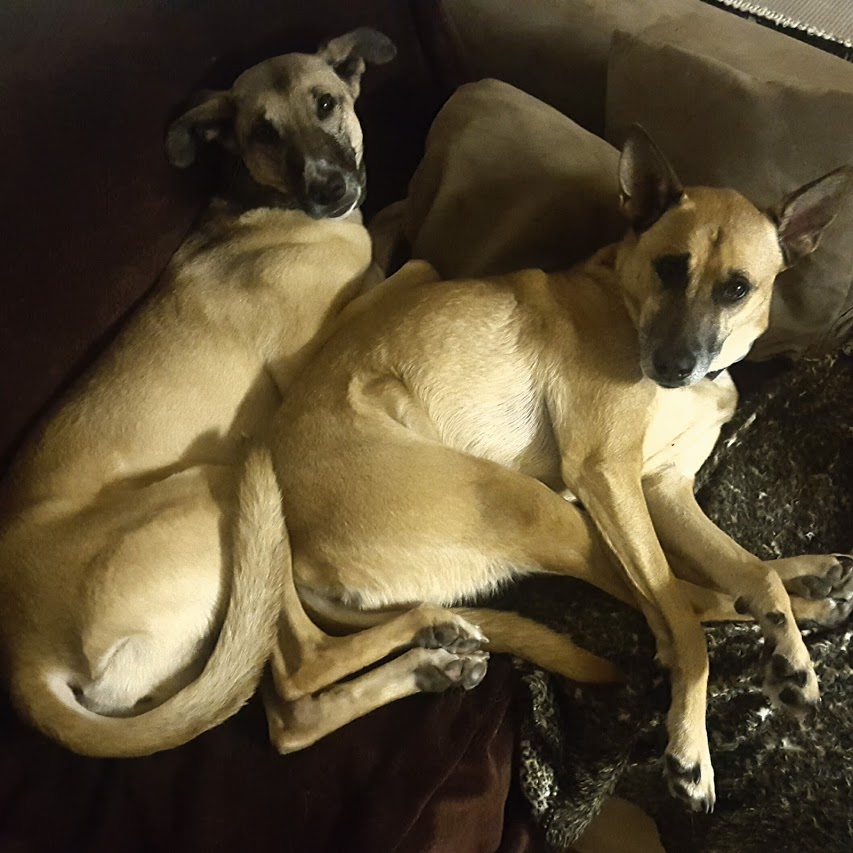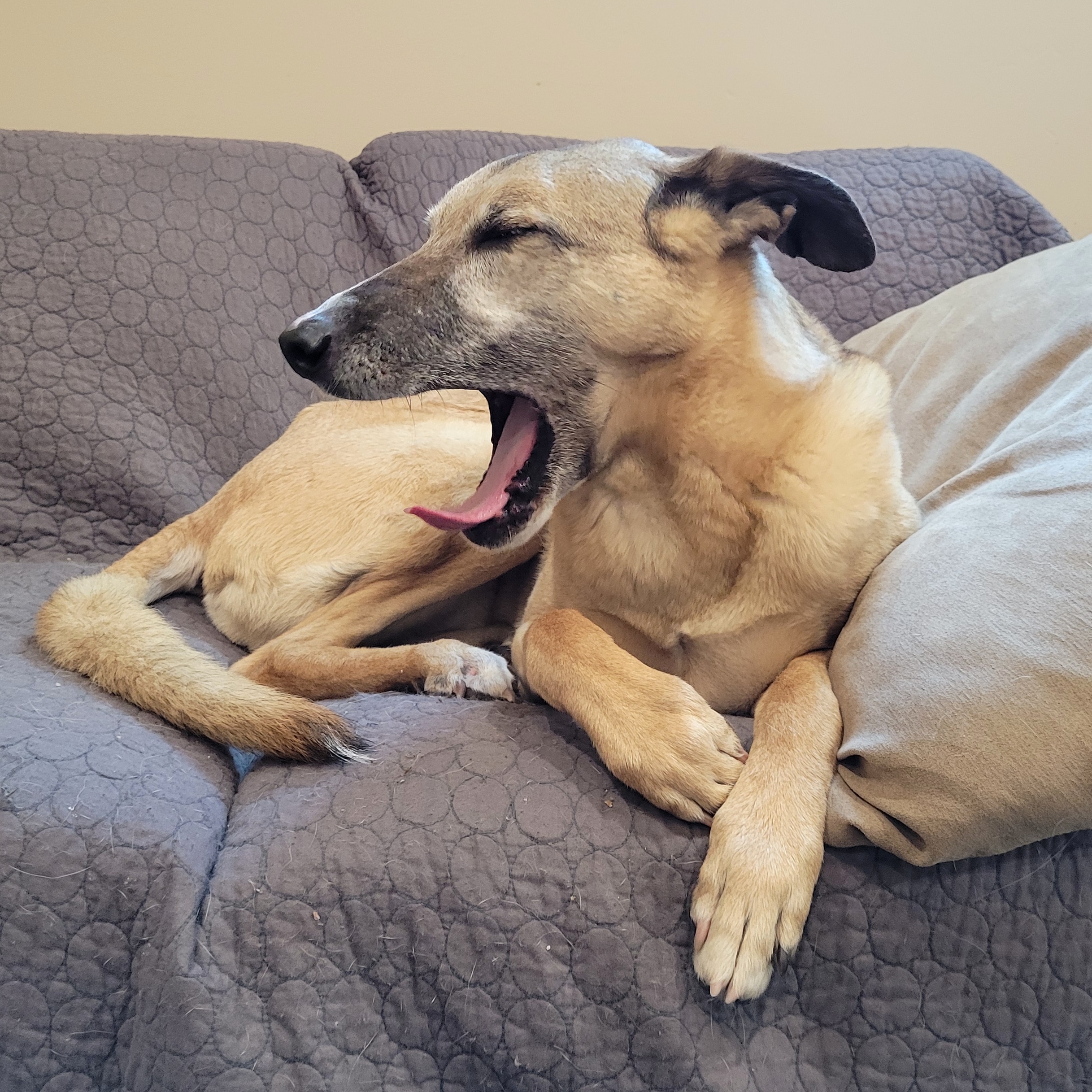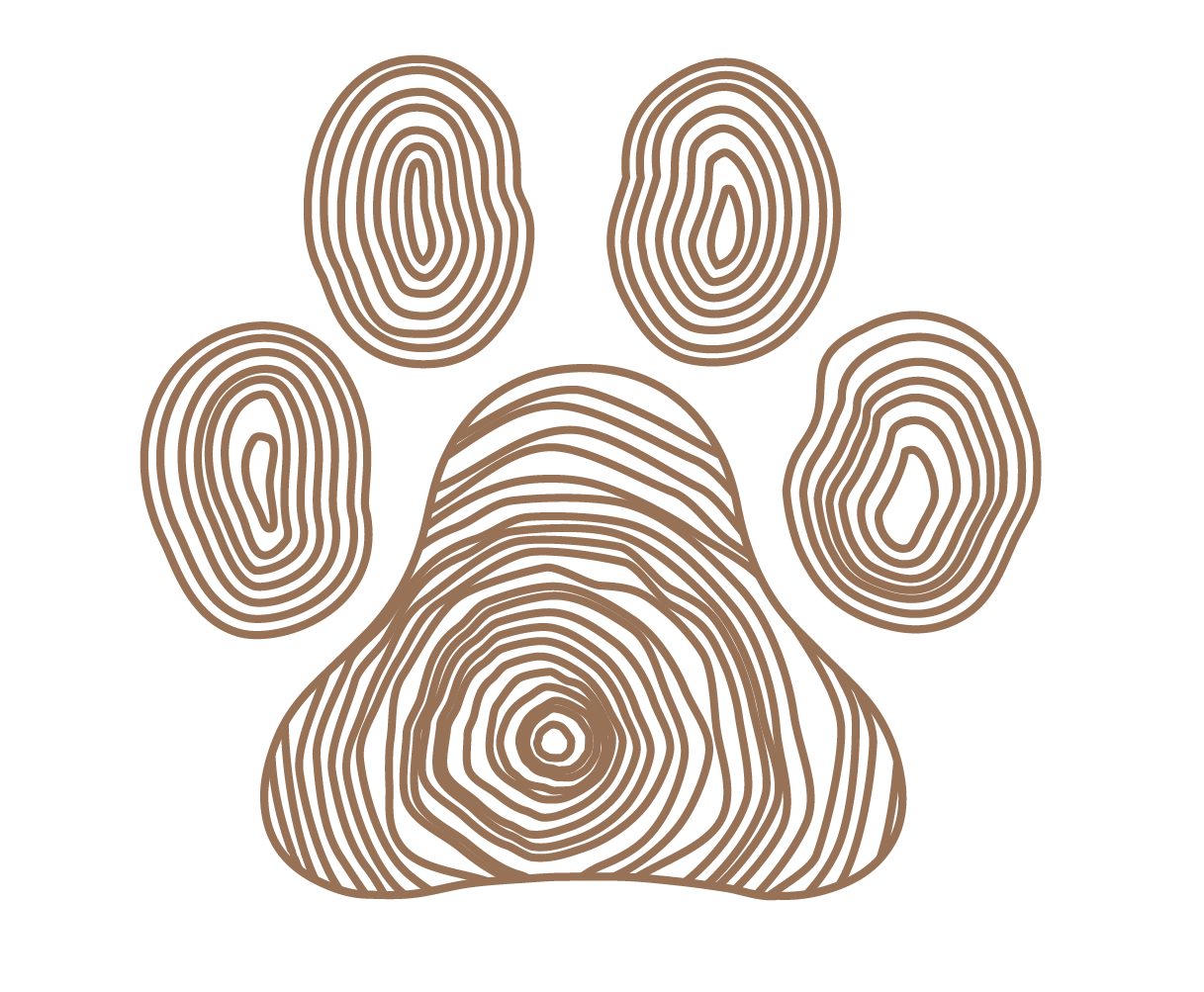If you have an anxious or fearful dog, or even one who displays explosive reactivity or aggression, there’s a good chance that someone, maybe even yourself, has asked if your dog was abused. Frequently this assumed past of physical violence, neglect, trauma, or general mistreatment is practically insisted upon by well intentioned souls, even when there is no known history of such– outside of the “proof” of the dog’s behavior.
I get that a lot about both my girls, but especially about Stormy.
Stormy is almost certainly part or mostly greyhound, the rest could be some kind of Shepherd. She’s tan, she’s got a lovely pointy sighthound nose, long legs, a deep & narrow chest, and she is an utter delight. She is also very, very fearful.

Stormy was brought into the shelter where I worked in Chico when she was about 10 weeks old, along with the rest of her litter. We sent the litter to our best puppy foster, a woman named Kathy who had redesigned her entire backyard to be appropriate for rearing foster puppies. She called me two days after taking this group home and said, “Lindsey, there’s one I can’t touch.” Stormy was backing away from the (very savvy) foster mom and growling at her. After discussion, we decided to move Stormy to a different foster home where she could live with another, more confident, adult dog rather than just her siblings. That seemed like it would work, but unfortunately after just a couple days she escaped through a small hole at the bottom of that second foster’s backyard fence and got herself lost in the wilderness of a park during a major, pipe-freezing cold snap. We all thought that she was gone at that point, but both her first and second fosters made an effort to keep walking the trails looking for her. To everyone’s surprise, she turned up and was brought back to the shelter. That was when I took her home.
Stormy immediately bonded with my other two dogs, Kisa, then 6, and Shine, who was about 3. They made a lovely pack together and enjoyed exploring the backyard, wrestling, and doing all the normal doggy things. But like her other fosters before me, Stormy wouldn’t let me touch her. She seemed happy and comfortable in the home with the dogs, but was still very fearful of human contact and interaction. I could not walk towards her, even indirectly, without her running in the opposite direction. Just being in the same space as me was hard for her, and numerous times I wondered if I was doing her a disservice not to have her euthanized because of the constant upset and fear she seemed to live with.
Like many fearful dogs, she avoided feeling “trapped” at all costs – she was much less anxious around me outdoors where she could easily flee than in the house. When the dogs were out in the backyard, in order to bring Stormy inside I would have to call everyone into the kitchen, toss a bunch of treats on the floor, and then go around from the opposite side to close the back door while everyone was eating the cookies, or else she would run out into the safety of the trees and bushes.
We made some progress over the months of fostering before I officially “failed” and adopted her, but it was very very slow. I remember one day when she was standing beside the arm of the couch where I was sitting and she allowed me to scratch the side of her neck while I wasn’t facing or looking at her; I felt incredible joy and gratitude for that moment. Small mercies.
Stormy finally bonded with me over the long and arduous drive from Chico to Vista (12 hours in the car with 3 dogs = no fun, though my ex got the worst of it: he was in the U-haul with 4 cats in carriers). It’s possible that her sudden increased comfort with me after the move was due to “stress bonding“ such as one sees in rabbits, or because once we got down here I was simply more familiar than the rest of the world, and more familiar = safer (“the evil you know,” etc). Whatever the case, she warmed up to me, but new people were still The Worst and she would at times blow her anal glands when I had friends come over.*

People who do not know her history assume that Stormy was abused. Because of her anxiety and fear around unfamiliar individuals, the way she spooks when people make sudden moves, and her sensitivity to environments and sounds, everyone wants to see her as the victim of some kind of mistreatment or trauma; I do not believe this is the case. As I said, we got her with her whole litter at 10 weeks old: they had all had the same upbringing, Stormy was just more fearful than the rest of them. Did the stress of being lost in the wods for a few days have an impact on her, too? Most likely, but let’s not forget that she was already growling and fleeing from humans prior to that event.
Generally speaking, people want to view dogs as blank slates when they are born: that “it’s all in how you raise them,” and that “it’s not the dog, it’s the owner”. We want dogs to be inherently “good”. But what is “good” for a dog? It’s no easier to discuss inherent goodness for dogs than it is for people, because like our canine family members we are born with baggage.
Science has shown over and over and over again that none of us, dog nor human, is a blank slate. We already know that genetic factors play a very significant role in the development of a dogs temperament and how they move through the world. If you aren’t already familiar with Belyaev’s silver fox experiment I’d strongly suggest doing some reading. It’s fascinating. (Sidebar: I was just reminded of the role of genetics in human personalities again listening to this episode of the wonderful podcast, Hidden Brain.)
There are plenty of factors other than trauma and DNA and that can cause behavioral changes. Lack of proper socialization as a puppy is the best known. An little known one that is both sad and interesting is that stress experienced by a mother can affect her babies. Another is that a dog may associate an unpleasant event with something that was present at the time, even if that particular stimulus didn’t cause it–this is in fact how shock-collar rattlesnake avoidance training works… that is, when it doesn’t cause dogs to become aggressive to snake-shaped things or fearful of other stuff present at the moment of the shock.
I recently had the opportunity to assist and do a bit of teaching at a birthday party for a litter of 13 puppies who had all just turned one year old. The human who helped deliver mama-Shadow’s exceptional number of puppies took incredible notes during the whelping process including the time of each puppies birth, and therefore birth order. The yearlings that I met included some very confident and outgoing dogs as well as a few much more fearful, anxious, and timid ones… and the spectrum of most to least confident paralleled first to last born, almost exactly.
Assuming that this birth order thing is in fact a case of causation causing correlation rather than coincidence, I still wouldn’t be able to tell you why that was the case. There are probably articles out there, you’re welcome to look them up and get me some answers, about why birth order of puppies has an effect on temperament. It might have to do with placement in the womb, nutrients getting to the puppies in utero, or access to the best milk once they are out of the womb and nursing.
Whatever case, I’m guessing that Stormy was probably the last puppy out from her litter. It’s a guess, but I think it’s a safer assumption to explain her increased fearfulness compared to her littlermates than that she experienced some kind of trauma, abuse or in-utero stress that the other four puppies didn’t.
Was she abused? Not by a person, not likely. Maybe she was mistreated by fate, to have been handed the short straw and the life with more stress, anxiety, and fear than the average dog. She doesn’t like meeting new people, going for car rides, taking walks outside of familiar spots, and the booms from Camp Pendleton, thunderclaps, or dreaded 4th of July fireworks send her info a panic. There’s some much about her life that’s difficult, but did she really draw the short straw? It was because of her problematic behavior and unstable temperament that she landed in my home, with my pack, bringing joy, snuggles and laughter along with the moments of fear.
I have no regrets about taking Stormy home as a foster, despite the number of times in the beginning of our life together that I didn’t know if I was doing the right thing by keeping her alive: I could see how hard it was just to be her, but that was over 10 years ago.
She is now super cuddly with me and (eventually) with visitors to my home. She demands butt scratches in a way very similar to this, and while she still doesn’t know the “sit” cue (which is another post entirely) she is an integral part of the pack, quirks and all. No matter the reasons that she is who she is, I am grateful for her and the weird twists of fate, DNA, chemicals, and circumstances that make her who she is and that brought her into my life.

*Liz and Athena – thank you for being the incredible & stink-tolerant souls you are. Love and miss you both. ❤

